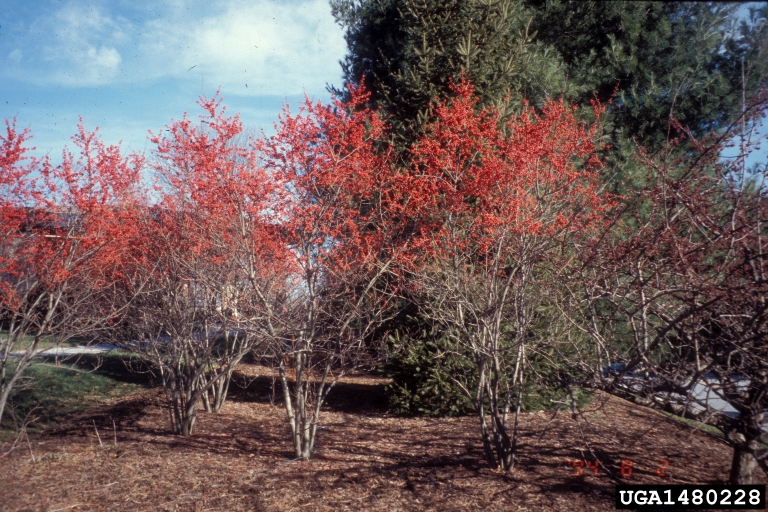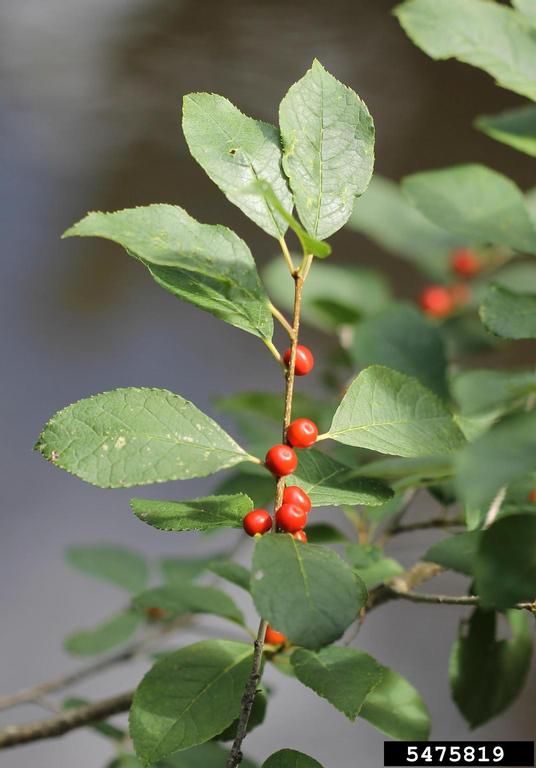In the month of December, the time of the year has begun when our landscapes look so drab and lifeless. Most of our deciduous plants have lost their leaves and the grass has turned brown. However, with Christmas coming, the green of the evergreens is always more impacting when it is paired with a plant with red berries. A great red fruiting shrub to place near evergreen trees and shrubs for winter and Christmas interest would be Winterberry.
Winterberry, Ilex verticillata, is a deciduous shrub that is grown mainly for the berries that give it winter interest. This shrub grows up to 6-10 feet tall and will sucker to form a colony. The 2-3 inches long, dark green leaves are alternately arranged on the branches. The bright red berries develop in the late summer and last until January. After the leaves fall off, the berries become more noticeable and this is when a winterberry shrub shines. The berries are ¼ inch across and are held on the shrub single or in a group of three.
There are many great choices of winterberry varieties to choose from. However, winterberry is a dioecious plant, meaning that male and female plants are on separate plants. It is necessary to have both male and female plants within 40-50 feet of each other to produce fruit. Good male pollinator varieties include ‘Apollo’, ‘Southern Gentleman’, and ‘Jim Dandy’. Good red blooming varieties include ‘Red Sprite’ which is a compact rounded form that grows up to 3 foot tall and wide. Other red fruiting varieties include ‘Winter Red’, ‘Sparkleberry’, ‘Berry Nice’, and ‘Berry Heavy’. There are also a few varieties that have orange fruits which include ‘Afterglow’ which is more compact and ‘Aurantiaca’.
Winterberry is a great shrub choice for the winter. It can be used in a variety of locations throughout your landscape. It can be added to a windbreak for more interest, more wildlife habitat, and more protection from strong winds or it can be used in a massing in your landscape. Winterberry will tolerate part shade and wet soils so it can be used in locations where other plants cannot. The biggest environmental intolerance of winterberry is high pH as this plant is prone to chlorosis in very basic soils such as clay.
Winterberry is a good choice for wildlife as well. Many songbirds, waterfowl, and game birds eat the berries but they choose to eat the berries of winterberry after feeding on other berries with a higher fat content. According to Clemson University, the fruit may be slightly toxic if ingested in large quantities. Clemson University also states that Native Americans used bark from winterberry as an antiseptic and they made tea to treat nausea from dried and crumbled leaves. Also, according to Clemson University, Bees and Butterflies are commonly found as pollinators for this plant.
Winterberry is a great choice to add some color to your bland winter landscape. Once the leaves fall off this plant in the fall, the berries are an added treat to decorate your landscape naturally for the holidays. It can be planted in many locations throughout your landscape, even in those swampy areas that tend to hold water. Be sure to plant both a male and female cultivar to ensure you get the berries for your landscape, and the next time you need a new shrub, consider Winterberry.


